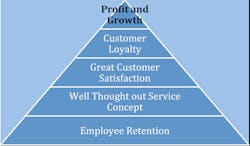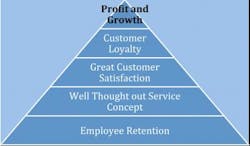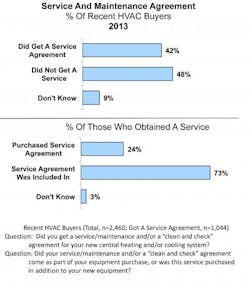I first became aware of The “Service Profit Chain” in the early 90s, and presented a version of it for HVAC contractors in an early Comfortech conference. It was and is based on the premise that within service industries, there is a relationship between profitability, customer loyalty, and employee satisfaction.
So after all of these years the question remains; can we have customer loyalty and retention in the HVAC industry? And will it lead to profit and growth? The answer is, You bet! And many do!
It all comes down to customer loyalty driving profit and growth, satisfaction driving loyalty, value driving satisfaction, and the employee driving value which is ensured by employee productivity.
In an industry that is based on a product not thought of by the customer until it fails —and it doesn’t fail often — the idea of building such a profit chain seemed hopeless. You hired to meet the season, and laid-off after the season was over. That may still be the business model in your shop. After all, in an industry driven by weather, and a local economy, how can you build a service company profit chain? You can’t…You have to do it by refocusing your business from fix-it or replace-it, to the service agreement, and building a long term relationship with the homeowner.
Think about building a service agreement business that pays all of your overhead, then using it to build a relationship with your customer. This is a real change to the old business model. Now you base your success base on making guaranteed money — $250.00 a year, per customer, each year.
However, converting your focus to service agreements can be hard. Many initially used new technicians to run the inspections, making them productive to your operation more quickly. It made sense, didn’t it? Sometimes, maybe, but many customers didn’t feel comfortable with a novice inspecting their systems, and even less excited about thinking they could be the homeowner’s consultant. A good alternative was a model that built direct customer, technician bonds by assigning specific customer care to specific technicians.
Fear of losing your technicians is scary. Building a way for your technicians’ to become successful within the company is exciting. This is the part (employee satisfaction) that you must also achieve to make the system work.
Relationships turn to trust, and trust allows the technician
and homeowner to discuss ways the homeowner could save
energy, and expand comfort in their home in a planned way.
Like an advertising agency with their account teams, your technician teams’ job and their pay is based on their ability to build a service relationship with their homeowners. It stands to reason they need enough homeowner clients to build their base, and not so many that they can't consult with them when in their home.
Relationships turn to trust, and trust allows the technician and homeowner to discuss ways the homeowner could save energy, and expand comfort in their home in a planned way. Setting yourself up as the ultimate expert, and the one calling the customer after each technician visit to ensure the customer’s satisfaction has also helped keep your reputation high in your technician’s customer’s mind.
It meant hiring right, and training technicians to do the right thing for their customers, and not the short term most profitable thing. It means hiring and training technicians to spend the time consulting with and helping their customer with their customer’s home comfort needs.
Where are we today? The chart below identifies the success of service agreements in the homes of newly purchased central HVAC products.
Service agreements are now included in the sale in four in 10 homes where new central HVAC, equipment is bought. That means many of you reading this have already shifted your focus to service agreements and the possible Service Profit Chain, through the use of those service agreements.
I would find the above numbers unnerving if my company was not in the service agreement business. It means my competitors are providing their customer with a relationship building product that could tie that customer to them for a life time. I know where that could leave me and my company, if I don’t find a way toward that business model – out of luck.
The new business model isn’t easy, at least at first. I was one recipient of a broadcast e-mail from a contractor the other day telling a group of us, they were fed up trying to manage their 400 + service agreement contracts. I would imagine many recipients of the e-mail immediately offered to take them off his hands.
So Service Profit Chain for your business or not! It is your business, and your decision.
To learn more about the “Service Business Profit Chain,” Google it when you get a chance. There are many entries that better explain the business model, and ways to implement it. It is up to you to find the best way to include it in your business.
As many of you know, my business has included researching the HVAC industry since 1985. For questions about customer loyalty research and/or employee research contact me at [email protected]. I’ve had a chance to work with some of the best of you in the past, and with many of the best consultants who help you train your technicians.
Decision Analyst’s American Home Comfort Study of homeowners explores what customers look for in HVAC contractors. To learn more about this study, or to purchase it, contact Garry, at [email protected].


